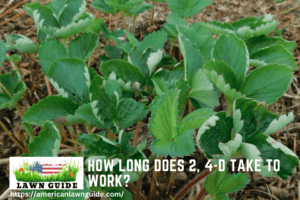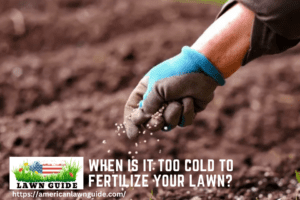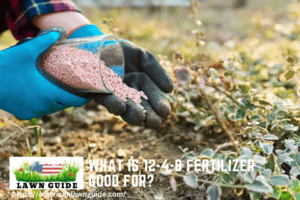The general rule of thumb is that if the ground is frozen, it’s too cold to fertilize. This means that in most cases, you shouldn’t try to fertilize your lawn until the spring thaw.
When temperatures start to dip below 50 degrees Fahrenheit, it’s time to stop fertilizing your lawn. Applying fertilizer in cold weather can damage the grass and make it more susceptible to disease. So if you’re looking to give your lawn a little boost, wait until the weather warms up again before applying any fertilizer.
WHEN and HOW to FERTILIZE your lawn
Is It Ok to Fertilize Lawn in Cold Weather?
It’s perfectly fine to fertilize your lawn in cold weather! In fact, it’s actually beneficial to do so because the nutrients in the fertilizer will be released more slowly due to the cooler temperatures. This means that your grass will have a longer period of time to absorb them, which is ideal for promoting healthy growth.
Of course, you’ll want to take care not to apply too much fertilizer at once since this can still cause problems even in chilly weather. It’s always best to err on the side of caution and use a little less than you think you need rather than risk damaging your lawn.
When Should You Not Fertilize Your Lawn?
It’s important to fertilize your lawn regularly to keep it looking its best. However, there are a few times when you should hold off on fertilizing. Here are four times when you shouldn’t fertilize your lawn:
- If the grass is already green and healthy, there’s no need to add fertilizer. Fertilizer won’t make the grass any greener or healthier.
- Avoid applying fertilizer before a rainstorm. The rain will wash the fertilizer away before it has a chance to be absorbed by the grass roots.
- Don’t fertilize if the temperature is below 50 degrees Fahrenheit. The cold weather will slow down the process of fertilizer absorption.
- Never apply more than the recommended amount of fertilizer. Applying too much can damage the grass and even kill it outright.
At What Temperature Can You Fertilize Your Lawn?
If you want to have a green, healthy lawn, you need to fertilize it. But when is the best time to do so? The answer may surprise you – it depends on the temperature!
Here’s a quick guide to help you figure out when to fertilize your lawn based on the temperature:
- If the temperature is below 60 degrees Fahrenheit, hold off on fertilizing. The cooler weather will slow down the growth of your grass, so there’s no need to encourage it with fertilizer. Plus, any fertilizer you apply will just sit on the surface of the ground and could be washed away by rain or snow.
- Between 60 and 80 degrees Fahrenheit is the ideal range for applying fertilizer. At these temperatures, your grass is actively growing and will make use of all those extra nutrients in the fertilizer. Just be sure not to overdo it – too much fertilizer can actually burn your lawn!
- Above 80 degrees Fahrenheit, it’s not advisable to fertilize your lawn. The hot weather will cause the fertilizer to break down quickly, which means that most of its nutrients will be wasted.
In addition, high temperatures put stress on your grass, so giving it more food isn’t going to help it thrive. Wait until things cool down before giving your lawn a boost with fertilizer.
Can You Fertilize Your Lawn After a Frost?
The short answer is yes, you can fertilize your lawn after a frost. However, there are a few things to keep in mind before doing so. Frost can damage turf grass leaves, causing them to turn brown and wilt.
If the damage is severe enough, it can kill the grass outright. Fertilizing immediately after a frost can actually further damage the grass, as the fertilizer will cause the leaves to break down even faster. It’s best to wait until the grass has fully recovered from the frost before fertilizing.
This means waiting until all of the leaves have turned green again and are actively growing. Once the grass is healthy again, then you can apply fertilizer according to your usual schedule.

When is It Too Cold to Fertilize Lawn in Fall?
It’s generally recommended that you fertilize your lawn in the fall, but there are a few things to consider before doing so. The first is the temperature. If it’s too cold outside, the fertilizer won’t be as effective.
So, if you live in an area where temperatures dip below freezing regularly in the fall, it’s best to wait until spring to fertilize your lawn. Another thing to consider is how late into the fall season it is. The closer it gets to winter, the less time your lawn has to absorb nutrients from the fertilizer.
So, if you’re getting close to winter weather, it might be better to wait until springtime again for fertilizing. If you do decide to fertilize your lawn in the fall, just be sure to follow the directions on the fertilizer package and don’t overdo it. A little goes a long way when it comes to Lawn care!
Best Temperature to Fertilize Lawn in Summer
The best time to fertilize your lawn in the summer is when the grass is actively growing. The ideal temperature for grass growth is between 77-85 degrees Fahrenheit. If you live in an area with hot summers, it’s best to apply fertilizer early in the morning or evening when temperatures are cooler.
Avoid applying fertilizer during the heat of the day to reduce the risk of scorching your lawn.
When to Apply Winter Fertilizer?
If you live in an area with a lot of snow, you may be wondering when the best time to apply winter fertilizer is. The answer depends on a few factors, including the type of grass you have and the amount of snowfall you typically get. For most types of grass, applying winter fertilizer in late fall is ideal.
This gives the grass a chance to absorb the nutrients before the ground freezes over. If you live in an area with very little snowfall, you can get away with applying winter fertilizer a bit later in the season – around early December. However, if you live in an area that gets a lot of snow, it’s important to apply winter fertilizer sooner rather than later.
This is because the heavy snowfall can cover up the fertilizer and prevent the grass from getting any benefit from it. In these cases, applying winter fertilizer in mid-November is usually best. Keep in mind that timing isn’t everything when it comes to fertilizing your lawn.
It’s also important to choose a high-quality fertilizer that’s specifically designed for use during the winter months. Using the wrong type of fertilizer can actually do more harm than good, so be sure to do your research before buying anything.
Conclusion
If you’re wondering when is too cold to fertilize your lawn, the answer may depend on the type of fertilizer you’re using. If you’re using a chemical fertilizer, it’s generally recommended that you wait until the temperature is above freezing before applying. However, if you’re using an organic fertilizer, there’s no need to wait and you can apply it even when the temperature is below freezing.




